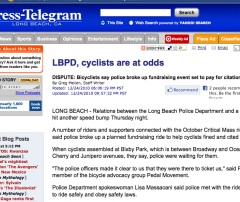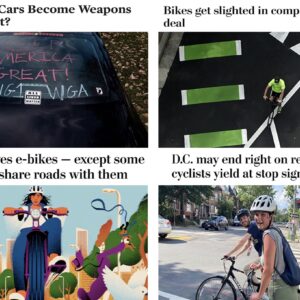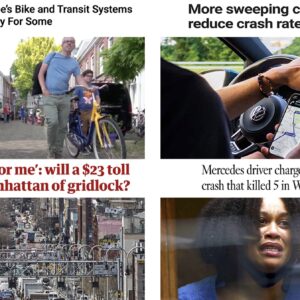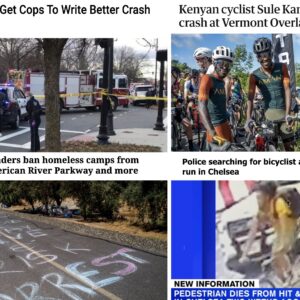
– This one’s for all you east coast readers weathering the weekend’s surprise blizzard — some tips from bikey, wintry Toronto on how to ride safely in the snow (and when to leave the bike at home). For further inspiration: pictures from Copenhagen.
– The saga of Long Beach, California continues with police breaking up an organized ride and the police chief likening fixed gear riding to drunk driving.
– In Cambodia, the rate of traffic crash injuries and deaths is so high, and affects the poor so disproportionately, that it’s being called a humanitarian crisis. People who rely on walking, bicycling, and motorbikes are at the highest risk.
– A recent study finds that teenage girls do better in school if they ride a bike or walk to school, perhaps because girls are less active than boys overall at that age.
– How do people’s attitudes about class and social standing affect transportation choices and behavior on the road? The question is fascinatingly unpacked here, complete with great political quotations.
– Michigan has passed a Complete Streets bill. Though no program has been funded, this means the state is now required to consider access for all mode users as equal to the concern of moving motorists efficiently between points.
– A district in New Zealand has approved millions of dollars of funding for bicycling and walking infrastructure, with a focus on off-road paths.
– In Tampa, a prominent member of the community is killed while bicycling, and his son and associates become unlikely bicycle advocates.
– New York City’s recent bicycle transformation has been largely due to the efforts of city transportation commissioner Janette Sadik-Khan. In an interview, she talks about how she made it happen, responds to detractors, and encourages other cities to be equally bold.
– For you numbers lovers, here’s a critical look at a recent paper analyzing the extensive data collected about the Velo’v bikesharing system in Lyon, France.
– In the former bicycle city of Beijing, despite a big push for sustainable transportation that mysteriously coincided with the Olympics, the city has failed to build and design its streets to accommodate a dramatic surge in the demand for private cars — meanwhile using policy to encourage that surge, with perhaps predictably disastrous consequences.
– A look at the mechanical particulars of generating electrical power by bicycle.
Video of the week: Vimeo user “CinelliDog” posted a vintage track racing video shot at Portland’s Alpenrose Velodrome in the mid 1970s. Great vintage racing action that gives you a sense of the history and legacy of Portland’s racing scene:
Alpenrose Velodrome 1974 – 1975 from CinelliDog on Vimeo.




Thanks for reading.
BikePortland has served this community with independent community journalism since 2005. We rely on subscriptions from readers like you to survive. Your financial support is vital in keeping this valuable resource alive and well.
Please subscribe today to strengthen and expand our work.
I take issue with the first post: the police chief did not directly liken fixed gear riding to drunk driving. Please read the entire article and the referenced quote before reposting someone else’s (misleading) statement as your own.
The police chief was stating that a police officer cannot allow a person to continue to break the law once they become aware of the situation; that their department would then become liable.
Is it really that hard to imagine a cyclist, or their surviving family, suing the police department if the officers allowed the cyclist to continue a ride (not in compliance with the local laws) and then that cyclist was involved in an accident? What about if the cyclist hit a pedestrian and seriously injured them? Not likely that the cyclist would get sued, they are not insured for that and the payout would be small, but Officer BikeFriendly that allowed this crash to happen? His office is insured by the good taxpayers.
The direct quote:
“If you’re out there and you’re driving around with no brakes, then if a police officer stops you and allows you to continue, knowing you have no brakes, there’s a liability issue for the City. We can’t, in good faith . . . It’s like stopping somebody who’s driving under the influence, you become aware they’re under the influence, and you say, ‘Be safe,’ you know, ‘be careful, go ahead,’ and you let them continue in an unsafe manner. We can’t do that; we won’t do that.”
I think you are missing the point. It’s the fact that he (Police Chief) compared riding a fixed gear with no brakes to drinking and driving. That is just not a fair comparison. It leads the reader to believe that a brakeless fixed gear rider is just as dangerous as a drunk driver, and that is just not true. It would have been a much more realistic comparison if he had compared, reckless pedestrian crossing of a roadway (jaywalking) to riding brakeless instead of driving under the influence.
I’ve been stopped by police in my car for my driver’s side headlight being out. This is a safety concern and could lead to an accident. The policeman didn’t require me to leave my car and find another way home even though I was a safety risk and not in compliance with local laws. I guess there could have been a lawsuit if an accident had ensued, but general reasonableness and likelihood of the suit ruled frivolous dictates the result that the officer let me go on with a warning.
Saying a fixed gear bicycle has no brakes is incorrect. If the local code requires a front brake then the officer should write a citation and move on. The public threat is nominal at best, and is far less than a drunk driver which the Police Chief did liken to a front brake-less fixed gear bicycle.
“… and is far less than a drunk driver which the Police Chief did liken to a front brake-less fixed gear bicycle. …rider
The Police Chief did not liken drunk driving to a front brake-less fixed gear bicycle. In fact, in his comment, he didn’t even mention bikes. Apparently though, the chief was inferring that a bike ridden without brakes is unsafe, and that for police officers to not stop and cite a person riding such a bike would be irresponsible as also would be knowingly allowing a drunk driver to continue on their way. The chief simply says both examples of road use are unsafe, and as such, officers have an obligation to stop people that involved in them.
The chief in his comment, doesn’t take up the debate about whether fixed gear riders backpedaling their bikes drivetrain constitutes a ‘brake’, no does he make any comparison between fixed gear riders in general and drunk drivers.
According to the Long Beach Post, here’s what the chief said:
“… Here’s the exact quote:
If you’re out there and you’re driving around with no brakes, then if a police officer stops you and allows you to continue, knowing you have no brakes, there’s a liability issue for the City. We can’t, in good faith . . . It’s like stopping somebody who’s driving under the influence, you become aware they’re under the influence, and you say, ‘Be safe,’ you know, ‘be careful, go ahead,’ and you let them continue in an unsafe manner. We can’t do that; we won’t do that. …” Long Beach Post/Greggory Moore/ 11.12.10
Maybe Chief McDonnell didn’t mean to compare riding a fixie to driving drunk, but compare them he did. He was making a statement about stopping dangerous behavior, and he essentially said that driving drunk and riding a fixie with no bonus brake are both dangerous. By making this comparison, he–perhaps unwittingly–implied that they were equally dangerous. Anyone who believes that driving drunk and riding a fixie sober are equally dangerous is not a critical thinker, yet the vast majority of those who happen to read–or worse, hear about second-hand–this statement, will now believe that riding one of those “brakeless” fixed gear bicycles is as dangerous as driving drunk!
Did he imply that they were equally as dangerous? I read it as they were both dangerous acts, police are required to uphold the law and curtail dangerous acts, and therefore are required to act.
Are you suggesting that he should have phrased (or dumbed-down) his statement so that non-critical thinkers could fully grasp what he was saying?
I’m saying he could have picked a better comparison. It is arguable whether riding a fixie with “no brake” is even dangerous at all if one has the proper skills. Comparing a technical equipment violation to operating a motor vehicle drunk is a lame thing to do. “Rider” had a better comparison in comments above: stopping a driver who has a headlight or brake light out. Would a driver be detained and have his car impounded for that?
If the gross immediate consequence for drunk driving and riding brakeless fixies is the same (confiscation of one’s vehicle), then aren’t we implying that the offenses are equally intolerable? The chief is rationalizing confiscation of bikes by claiming he has the same responsibility to immediately get fixed-gear riders off the street as he does to get drunk drivers off the street. Does that not imply that the two activities warrant equal attention because they are an equal threat?
Could the chief have made a more realistic comparison? What about drivers driving around in cars with bald tires? Do they have to surrender their vehicles on the spot? Or do they get an equipment citation and instructions to replace their tires ASAP? (Does anyone even get stopped for having bald tires?) There are innumerable other examples that are more apropos, yet the chief chose the comparison he did–why? One can’t help but wonder whether he was trying just a little bit to blow the “danger” of fixed-gear riding way out of proportion, after the fact, to justify unfair actions taken against cyclists.
The chief, in mentioning the two road uses in the same comment, opened them up to comparison by all that read his comment, but he did not say or appear to imply they were equally unsafe uses of the road.
Everybody, but probably public officials more than the average person, bear some responsibility to anticipate whether or not certain words they speak may imply to those that hear and read them, something other than what they specifically say.
“… yet the vast majority of those who happen to read–or worse, hear about second-hand–this statement, will now believe that riding one of those “brakeless” fixed gear bicycles is as dangerous as driving drunk! …” El Biciclero
As dangerous as drunk driving to the rider? Or, to the other people on the road? Who is it that might be reading or hearing about his statement? If it’s people of average or better intelligence, it’s most likely they won’t come to believe that “… riding one of those “brakeless” fixed gear bicycles is as dangerous as driving drunk! …”.
I think that if the chief really thought that drivetrain braked fixie bike riding was just as unsafe and dangerous as driving a car drunk, and he wanted to make a claim to that effect, he would have said as much. He didn’t say that.
If maus and blue really want a story with some teeth in it, they might consider giving the police chief a call and see if he’ll answer more specifically for a direct comment to bikeportland, to what extent he believes fixie riding and drunk driving may or may not comparable. Maybe they’d also get some other useful information, such as, how many fixie riders his officers are actually having occasion to cite for riding bikes without brakes.
Sorry, let me correct that, “did liken through inference.” There ya go.
The pedal-a-watt article is full of errors. Pedaling for the purpose of generating electrical power is a very interesting pursuit and many have worked on perfecting this, but sustaining 200W is outside the range of I would say just about everyone. See this much more thoroughly documented discussion of the issue:
http://www.los-gatos.ca.us/davidbu/pedgen.html
Just about everyone? I would guess that anyone that races a bike at a cat. 3 or above could do 2 hours at 200 watts rather easily. I know I could. When doing Lactate Threshold testing, you are looking for maximum sustained wattage for about an hour (which is roughly your lactate threshold). A number in the 300s is very common for a well-trained athlete.
So while, yes, most people probably would struggle to maintain 200 watts for 2 hours. There are definitely a decent amount of cyclists who could do it rather easily.
I agree entirely, but I’m guessing 200 watts of power output at the cranks or hub is different from 200 watts of electricity produced by a pedal-powered generator, unfortunately. I bet at least half is lost to heat and attenuation.
I averaged over 200 watts in my very first LT test before dipping my hand in racing years ago (and I was pretty hung over at the time). Doing that LT test and adjusting my training accordingly was the best thing that ever happened to my health and endurance, by the way – I’m dying to get up to Portland to take another! (insert shameless plug for Seth Hosmer and hpchiro here…)
And I thought 9watts was in reference to your LED headlights. :v0
The Michigan Complete Streets story was little disappointing, because in his quoted comment, the story’s key professional source does not specifically say ‘motor vehicle traffic’…as the mode of travel that’s come to be recognized as one needing to cede some of the dominance over public streets it has come to have over the decades .
“… Even so, Clein says, “It’s a great start. The state has passed a bill that says flat out (that complete streets) has to be considered equally as important as how much traffic you can get from point A to point B. That’s important.” freep.com/JOHN GALLAGHER
FREE STAFF WRITER
Making such a specific note is important, because while enabling public streets to host a wide range of activities and modes is important, efficiently moving as large a volume of traffic as is possible…safely, comfortably, and practically, from point A to point B…is also going to continue to be an important concern.
Interesting that in the photo from the article about girls biking to school she is riding an electric bike. Probably just a stock photo I suppose.
The Long Beach article is another fine example of Jonathan and Elly teasing readers with a half truth to encourage clicking the link. You do it only to find that they hyped the article just to find it wasn’t the juicy anger inducing quote you were looking for. But, someone got paid.
BikePortland is becoming more and more like the lamestream media during a sweeps month. I imagine we’re not too far from headlines like, “Your Bike Can Injure or Kill You!” only to find the story is about periodically changing tires or brake pads or “Bike Ban Considered at Sellwood Neighborhood Meeting” just to find that a lone cranky homeowner issued an anti-bike missive during open public commentary.
Brad, I don’t agree with your characterization of Jonathan or Elly, but I have to say “lamestream media” is a priceless quote and I’m stealing that one for future conversation.
I like the old Alpenrose footage.
Does anyone know, has the track always been cement? (just wondering due to the discoloration in the footage). I can’t imagine it was ever wood with the kind of moisture we see here in Pdx.
Alpenrose has always been concrete/cement. In the early days, only parts of the track were painted. Over time, it has deteriorated to the point where the whole track is painted. Every year, there is a big paint party and several dedicated people spend a lot of time patching the cement before it gets painted. At times, it seems as though the paint is all that is holding the track together.
Jonathan, the “attitudes about class and cycling” article is excellent, and really deserves it’s own entry to your site. Everyone make sure to read it and forward it to people you know.
I especially liked this comment under the article
“I have affixed the hood ornament from my car to the top of my bike helmet, so everybody understands that I possess enough wealth to own a car but only choose to ride a bicycle. However, since I’m married, I suppose this practice is no longer necessary to attract a mate.”
I had a kid in one of those boxy things tell me to “get off the road and buy a car”. I reminded him he drives a car advertised by hamsters.
those people riding around copenhagen with snow-caked wet jeans looked miserable. do they sell waterproof and/or fast drying outerwear in denmark?
um, you’re seeing different photos than me? there’s 3 or 4 pics off copenhagenize and i’m sure the bikers are chilly but no one looks like they’re covered in snow or soaking wet.
click on pics and browse flickr album.
“In Cambodia, the rate of traffic crash injuries and deaths is so high, and affects the poor so disproportionately, that it’s being called a humanitarian crisis.”
Ok, seriously. Sensationalize much?
1. No where in the article, nor the report, was “crisis” mentioned, so I guess it’s only being called a crisis by BikePortland.
2. The death rate 4.7 per day, out of a population of over 14 million v. 93 per day in the US 307 million in the US; as a percentage of population, they are very very close. We do not call it a “humanitarian crises” here in the US.
3. “Affects the poor so disproportionately…”
Disproportionately was not used in the article or the report; so how does B.P. define disporportionate? Over 30% of the country lives below the poverty line; I imagine just as many live right above it. GDP is est. at less than $2500. It would be hard to hit hit someone who is not poor.
I understand the need to report on traffic attrocities worldwide, but let’s not blow things completely out of proportion, eh?
At least you did not blame it on US soldiers…
Sorry spelling police, I did misspell crisis.
spell “crisis” correctly in your text search and you will in fact find it in the article. also the word “humanitarian,” and also a reference to the poor being hit hardest.
I stand corrected: it was used once, in quotes, as a section header and with no further support or mention. I was actually looking for something to substantiate the claim.
I never questioned the use of humanitarian, nor did I refute that the poor were the hardest hit. I did question the assertion that it was disproportiate. I did not see that in the report. Doesn’t it stand to reason that if the larger proportion of the population is poor, then a larger proportion of incidents would involve them?
And I must have missed the part of the report that stated that the disproportion towards the poor is part of what makes this a crisis.
thirteen percent of fatalities were pedestrians, four percent cyclists, over seventeen percent motorbike, total “vulnerable” users somewhat more than a third. page 16. table 23 in the back correlates user category with occupation and age groupings. first three categories student, child, worker, farmer, soldier, etc. looks like a hierarchy of some kind. taking the first three categories only, we get over three hundred of the total sixteen hundred. calculates out to about 27 percent. throw in farmers, you got over 48 percent. i am going to guess farmers are fairly low on the economic food chain. a cambodian government document doesn’t have to call it a humanitarian crisis for some journalist to identify it as such.
Davemess,
Me and my friends used to play around on the velodrome before our Little League baseball games, back in 1972-73. I remember the track looking exactly like the video. The red paint was peeling and fairly dusty/dry/slippery. We would try to slide down the banked corners on our feet like we were skateboarding. Yes it was cement.
Brian
Glad to see Michigan being progressive in regards to Complete Streets. Sure, there’s no funding for it, but the intent is now there, which means when the money is there, they are now required to take those considerations into account. It’s only a first step, but it’s an important first step. More to the point, it’s one step further than many other states (which consider themselves MORE progressive) have gone.
“… I’m saying he could have picked a better comparison. …” El Biciclero December 27, 2010 at 6:00 pm (in reference to the Long Beach California Police Chief’s explanation of why the pd needed to stop fixie riders for having no brakes.
Probably could have, and should have. There’s another story here though, which is why it might have been worth maus and co. taking a look into it. Notice blue’s tying the critical mass story in with the story on the Chief’s comment?
I just wonder whether the Long Beach Police Department was finding the need to stop fixie riders before Critical Mass rides became something the pd felt it had to address.